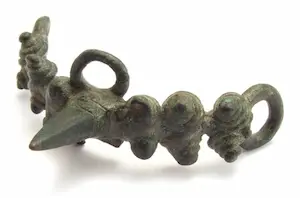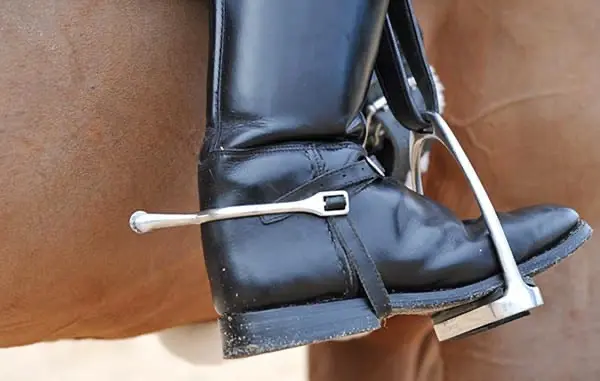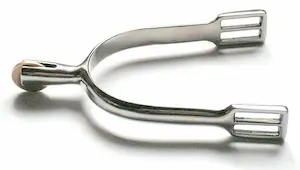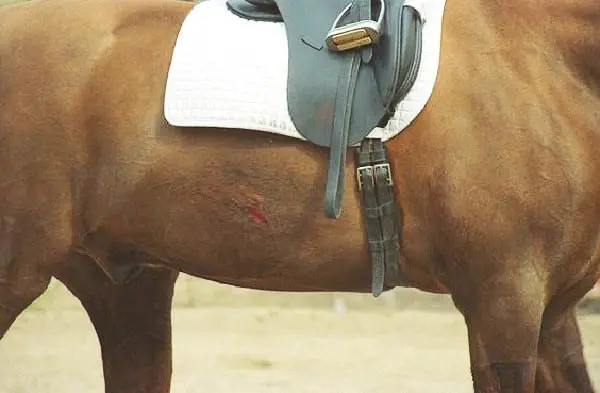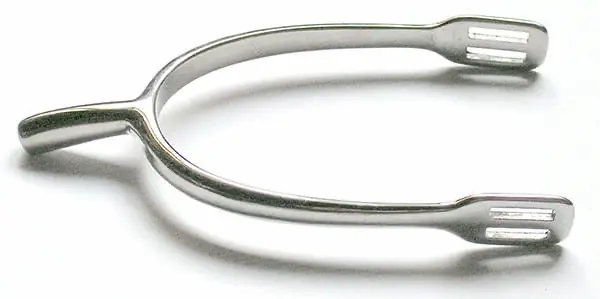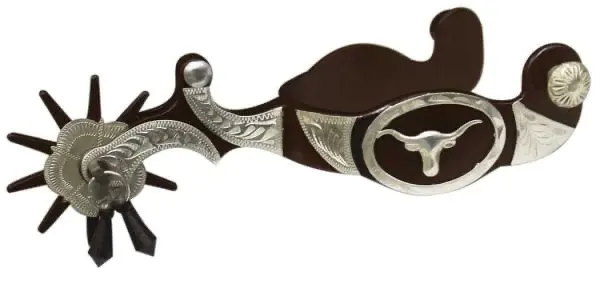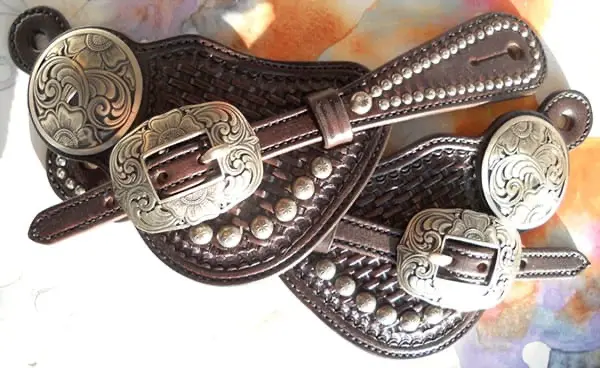Whether or not you should use spurs has always been a contentious issue with everybody having strong opinions on whether they’re a good or bad idea and even if they’re cruel or not. The problem with this though is that with such strong views it can be difficult, especially if you’re new to riding (or new to the idea of spurs), to know what the truth is, after all, if one person is insisting they’re cruel while somebody else is vehement they’re not they can’t both be right. This is why I decided to write this article, I don’t want to tell you what to do (or even what you shouldn’t do), I just want to give you the facts so you can use your judgment to make a better-informed decision.
Spurs should only be used as a riding aid
Before I start, one thing I will say about the use of spurs is that it’s important to keep in mind that they are a riding aid and should be only ever be used as aids. They’re not a substitute for poor riding or bad training and should never be used as such.
They’re designed to allow the rider to give the horse subtle signals that, certainly in disciplines such as dressage, are virtually invisible to the spectators. They shouldn’t be used to make a horse go faster.
A brief history of riding spurs
You might think that spurs have only been around for a few hundred years but, while their early incarnations were much cruder they’ve been used by riders the world over for thousands of years. First mentioned in 355BC by Xenophon in his seminal book, On Horsemanship, they were also used by the Celts at around 300BC and later the Roman Empire which began around 27BC.
Ever since the Middle Ages (when they were awarded to medieval knights), spurs have been gifted to certain individuals as a mark of their bravery or status. For example, members of the Papal Orders of Knighthood are given them directly by the pope while members of the Most Notable Order of the Garter are awarded them by King Charles III of Great Britain.
What are riding spurs used for?
Over the centuries the design of spurs has changed a great deal but the purpose of them, at least when riding, has always remained the same. Yes, they do have ceremonial and decorative uses, but when it comes to horse riding spurs are used solely as a riding aid. They’re used to back up the rider’s natural aids (such as seat, legs, hands, and voice) and are designed to direct the horse to move forward or laterally or to make them go faster.
All spurs are designed to allow the rider to give the horse very subtle signals (so subtle that they’re almost invisible) which can be done by flexing the heel slightly up and inwards. Rowelled spurs (those with a rotating wheel or ball at the end) also give the rider the ability to ‘roll’ them against the horse’s flank.
How do riding spurs work?
Spurs work by applying slight pressure on the sensitive area of a horse’s flanks, the area where the muscles and nerves cross. This area is extremely sensitive and even the lightest of pressure will cause an involuntary movement (similar to if somebody pokes you in the side of the ribs) which is what moves the horse forward.
The type of spur you use will play a role in how much pressure you apply but the biggest influence will be how much (or how little) you flex your heel. This is why a good seat and correct leg position are so crucial when using spurs.
Do spurs hurt the horse?
Sadly this is one of those questions that isn’t straightforward to answer and has a lot of conditionals, if you have a poor leg position then yes without hesitation they’ll hurt the horse but, likewise, if you have a perfect riding position but used sharp, pointed spurs they’ll hurt the horse too.
The best answer to this question, and the most honest one, is to say it depends on a number of factors. The type of spur, your position and balance, how gentle you are, and how sensitive your horse is.
In order to use them properly, it’s important to understand exactly how they work and what the spurs, and of course you, are doing. As a rule, unless you’re using ones with a sharp point, it’s not the spurs themselves that will hurt the horse but how they’re used. After all, used properly a gun won’t hurt anybody, but in the wrong hands, it can have devastating consequences. Okay so that may be a bit of an extreme example but you get what I mean.
When it comes to the design of the spurs they should be rounded with blunt ends or rounded rowels but the shank (the ‘neck’ that sticks out from the back of the spur and makes contact with the horse) shouldn’t be too long either. It’s about the distribution of the pressure, if you have too sharp a point then you’re exerting all of the pressure in one place, but if the end of the spur is blunt then you’re able to distribute the pressure more evenly. If you adhere to this the spurs will apply pressure, rather than pain, to the horse.
The shanks of the spur can also play a role in whether or not they hurt the horse, ideally, they should be around 1.5 inches (4cm), anything longer can put unnecessary and inadvertent pressure on your horse.
If you do use spurs then you should check them regularly for signs of wear, especially if you’re spending a lot of time walking through sand and dirt. Over time they can become pointy and should be replaced to avoid hurting your horse.
Many instructors argue that you should use spurs when learning to ride because it can make it easier to maneuver the horse but, in my opinion at least, I think you should only ever use them if you’re an experienced rider. There’s no substitute for proper training and inexperienced riders won’t have the balance that would otherwise help an experienced rider keep their leg still, therefore possibly hurting the horse, albeit inadvertently.
Another thing to consider is the time of year you’re using the spurs, I know that might sound like a strange thing to say but if you’re using spurs with rowels and your horse has a thick winter coat then his hair is likely to get plucked out as it’ll get caught in the rowels which will act like tweezers. To some extent though this can be minimized by spraying a little bit of ShowSheen (available on Amazon) on your horse’s coat beforehand. This will reduce the chance of it getting caught in the first place.
Typical problems caused by riding spurs
As I said before, spurs themselves won’t hurt but improper use can lead to a number of different issues, from minor injuries that will heal quickly to more serious behavioral problems that aren’t so easy to resolve. The most common problems associated with the incorrect use of spurs are:
- Broken skin – Scratches and scrapes in and around the flanks are the most common wounds found on horses whose riders aren’t using spurs correctly.
- Puncture wounds – Thankfully these aren’t so common but do require some form of medical intervention and treatment.
- Lesions on the flanks – These are normally caused by repeat wounds that aren’t allowed to heal properly.
- Defensive behavior – If you’re giving your horse mixed messages or are hurting him because you’re not using the spurs properly then it can result in a range of different behavioral issues such as being disobedient under saddle to bucking and generally being more aggressive.
What are the different types of riding spurs?
As you’d expect there’s a wide range of different spurs all with their own purpose but the most popular ones are:
- Dummy spurs – These are often used by inexperienced riders or in a show ring where the correct dress code means you need to wear spurs but you don’t need (or don’t want) the real effect of them. They don’t have a shank at all and are just the U-shaped bar that sits around the rider’s heel.
- Round end – As the name suggests these spurs have a rounded end to them and are probably the most gentle. The rounded end is typically a small metal ball that’s around the size of a small marble.
- Knob end – These have a small, squared-off end to them. This end though is blunted at the edges which is why they’re sometimes referred to as blunt end spurs.
- Prince of Wales – The most common of all English spurs, the Prince of Wales has a flat end that’s slightly sharper than the round end and knob end spurs. These spurs can be used facing up or down depending on your ability as a rider.
- Waterford – Similar to the round end spurs, the ball on these is larger which makes them a much gentler spur.
- Rowelled – More common in Western riding, these spurs have a rotating toothed wheel known as a rowel. The teeth are rounded, with smaller teeth being gentler. Rowelled spurs are becoming more common in English riding with variations such as disc and roller:
- Disc – The edges of these rowels are completely smooth with no teeth at all, the level of severity of these spurs depends on the thickness of the disc. Like the swan neck, these spurs are more popular in dressage.
- Roller spur – Considered to be very gentle on the horse, the shaft has a plastic roller that moves against the horse’s side. This is more beneficial to sensitive horses and can reduce spur rubs (marks left by the spurs).
- Swan neck – Looking like the neck of a swan, the shaft of these spurs goes upwards then levels out. The longer neck makes them a popular choice for dressage riders who can give their horse commands with barely noticeable movements.
- Barrel-racing spur – Also known as Le spur, these have small ridges on the inside of the heel band rather than on the shank. This means that the rider doesn’t need to turn their heel to use them which can make it easier for them to be used when not intended.
- Mounted – Popular in Western riding these are rowelled spurs that are decorated with precious metals and ornate tooling. The designs can be on one side (known as half mounted) or both sides (full mounted or double mounted) of the spurs.
- Jingle bob – I know these are mainly used for decoration rather than riding, but they’re the stereotypical ‘cowboy’ spur that most people think of when they think of spurs. They have pendants on the axel (where the rowel is attached to the shank) that give the distinctive jingle-jangle sound as you walk.
How to choose the right spurs for you AND your horse?
When it comes to choosing the right type of spurs you need to consider a number of things such as what you’re going to use them for (some organizations won’t allow certain designs of spur), the style of the rowel or end, and the length of the shank.
- Use – The first thing you need to take into account is what you need spurs for, don’t forget that they’re an aid and that improper use will hurt your horse.
- Riding style – The style of riding you do will play a big role in the style of spurs you opt for, after all, barrel racing spurs are no good if you do a lot of show jumping.
- Shank length– While some disciplines and organizations limit the length of the shank you will need a longer shank for disciplines such as dressage while others require a shorter shank.
- Fit – Once you’ve found the right style of spur you need to make sure they fit you properly. A correctly fitted spur will snuggly ‘hold’ the rider’s heel and rest comfortably on the heel or spur lip.
- Strap – If you ride English then the choice is limited to leather or synthetic, but if you ride Western then you’ll have a wide range of decorated straps.
Conclusion
Whether or not you choose to wear spurs should be based solely on your ability as a rider, while they can aid your communication they should never be used instead of natural cues. While spurs have changed a lot since the days of Xenophon and are gentler on the horse they are designed to create uncomfortable pressure on the horse.
Further reading
- Before you buy a horse
- How to be a better rider
- Core exercises for riders
- Riding with back pain
- Riding safely in snow
- How to stay safe riding at night
- Bits & mouthpieces explained
- Best riding gloves on the market
- Swimming with your horse
- Do horses like being ridden?
I hope you found this article helpful. If you did I’d be grateful if you could share it please as it would really help me.
Recommended products
Over the years I have tried hundreds of different horsey products, from various blankets and halters to different treats. Some I’ve loved, others I’ve hated but I thought I’d share with you my top all-time favorite products, the ones I never leave the yard without. I’ve included links to the products (which are in no particular order) that I really think are great.
- Horse Knots by Reference Ready – If you’re like me and enjoy pocket reference guides then you’ll love this knot tying guide. These handy cards can easily fit in your pocket or attach to the saddle for quick reference. They’re waterproof, durable and are color coded to make them easy to follow.
- Mane ’n Tail Detangler – Even if you never show your horse you’ll need to detangle his tail from time to time (and possibly his mane too) which is always a challenging chore! I’ve found that if I run a little bit of detangler through my horse’s tails every few days it stops them from getting matted up and makes combing them easy, even if they’re coated in mud. I don’t know if I should admit to this or not but it also works wonders on my hair.
- TAKEKIT Pro clippers – Over the years I’ve tried a lot of different clippers and while some were obviously better than others I found these to be by far the best. They are heavier than a lot of other clippers but for me, that’s a good thing, it makes them feel more sturdy and hardwearing. On top of that they have a range of speeds so are just as good for clipping your horse’s back as they are his face. I also like the fact that they come in a handy carry case but that’s not for everybody. The company that makes them is super good and incredibly helpful too, a real bonus these days. The only thing I wasn’t keen on was the fact that it doesn’t come with any oil, but that’s not a major problem as it’s not difficult to buy lubricant.
- Shire’s ball feeder – There are so many boredom buster toys out there but I like to use these every day, regardless of whether or not my horses are bored. I find that it helps to encourage my horses to problem solve by rewarding them with treats (or pieces of fruit) but it also mimics their natural grazing behavior which helps to keep them calm and de-stressed.
- Horse safe mirror – This is a strange one that many people are surprised about but I like to put horse safe mirrors in the trailers as well as in the quarantine stalls. It helps to prevent the feeling of isolation by giving the impression of other horses being around. Being herd animals horses can get extremely stressed when they feel that they’re on their own but with these stick-on mirrors, they believe that at least one other horse is with them.
- Rectal thermometer – I know this isn’t glamourous at all but it’s vital for your horse’s well-being to be able to check their temperature and a rectal thermometer is the easiest way of doing this which is why I’ve added it to the list.
Shopping lists
I’ve also put together a few shopping lists of essential items that I’ve found helpful over the years. I’ve broken the lists down into different categories rather than put everything in one massive list 😉

